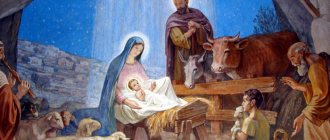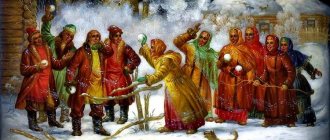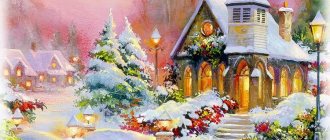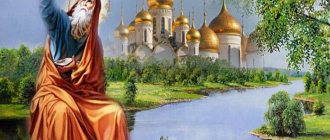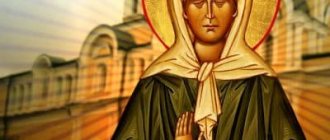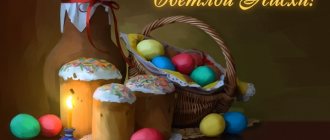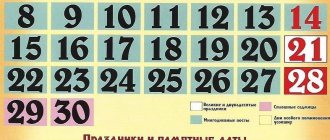In a series of numerous holidays of the Christian tradition, one occupies a special place - this is the day dedicated to the birth of Jesus Christ. It is especially revered and considered a great event after Easter. The evangelists Luke and Matthew describe in detail the birth of Christ in a cave near Bethlehem, how the centuries-old prophecy about the coming of the Savior to earth was fulfilled.
In European countries and America, the Christmas holiday falls on the last days of the outgoing year - December 25th. The traditions of the past are miraculously intertwined with the realities of modern life, and this is probably why the celebration is filled with special warmth, comfort, and harmony.
In Russia, Christmas is traditionally celebrated in January. The day falls on a long weekend, often called the Christmas holiday. Orthodox Christians honor traditions and customs, observe rituals aimed at peace, goodness, and bringing prosperity, prosperity, and peace of mind into the home and family.
When is it celebrated in Russia?
As in all previous periods, it falls on January 7th. The night from Monday the 6th to Tuesday the 7th of the first winter month will be illuminated by a service that takes place in all Orthodox churches. After this, the procession will begin. These events belong to centuries-old traditions that came to us from ancient times. All believers must follow certain rules - they are not allowed to quarrel, throw out garbage, clean, or work. These events must be completed before the holiday, and you should prepare for the event itself in advance.
Events underlying the holiday
Information about the ongoing events with which the appearance of the holiday is associated can be found in canonical sources - in the Gospel of Matthew and Luke.
If you study the first source of Matt. 1:18-25, then you can see information that Caesar Augustus issued a decree suggesting the need to conduct a census of residents. Those living on lands belonging to the Roman Empire must register in the places where they were born. Since Joseph was a representative of the Davidic family, he and the Virgin Mary had to visit Bethlehem. News that a new King had been born quickly spread throughout the lands of the Jews. In Matt. 2:16 tells about the reluctance of the ruling King Herod to get a competitor to the throne. Since he had no information about the whereabouts of the baby Jesus, he took the simplest but cruelest route - he ordered the killing of all children under the age of two, without exception. But Jesus was able to survive because an angel told Joseph about the danger. Tom managed to take the child to Egypt.
Similar descriptions are presented in apocryphal sources - in the Gospel of Pseudo-Matthew and the Proto-Gospel of James.
Yule story
Leonid Solomatkin. Slavishnitsy (fragment). 1868
In the name of the Yuletide story genre, there is an obvious reference to the concept of Christmastide. The Brockhaus and Efron Encyclopedic Dictionary gives the following definition:
“Sviatki, that is, holy days - twelve days after the Feast of the Nativity of Christ, before the Feast of the Epiphany. They are also called Christmas Eve, perhaps in memory of the events of the Nativity and baptism of the Savior, which took place at night or in the evening. The church began to sanctify the twelve days after the feast of the Nativity of Christ in ancient times...”
Almost all major writers who worked in periodicals in the second half of the 19th century wrote Christmas stories: Nikolai Leskov, Mikhail Saltykov-Shchedrin, Gleb Uspensky, Anton Chekhov, Dmitry Mamin-Sibiryak, Vladimir Korolenko, Pavel Zasodimsky, Leonid Andreev, Maxim Gorky . The Christmas issues of the magazines “Igrushechka” and “Zasushevnoye Slovo” published the stories “Christ Visiting a Man,” “The Unchangeable Ruble,” and “The Fool” by Nikolai Leskov. And Pavel Zasodimsky in 1883 published two volumes of children's “Intimate Stories”. Dmitry Mamin-Sibiryak writes children's Christmas stories for the collection “Zarnitsy. The second collection of stories for older adults."
Often Christmas stories were created not for entertainment, but for teaching children. The authors turned to Christian themes and created stories based on them that were simple and understandable to children. The format of the Christmas story was convenient for teaching - the themes of morality, holiness, kindness, self-sacrifice and honesty fit organically here.
Subsequently, the genre of Christmas stories began to develop in two directions. The genre of the story itself became so widespread that all writers, both professional and beginners, turned to it, so that Christmas stories turned into easy sentimental reading without any special literary delights. At the same time, the Christmas story for many writers became a field for experimentation and a way to form a new literary direction.
Celebration date
The ancient Jews, considered the first representatives of Christianity, considered the fact of birth as the beginning of “sorrows and pains.” Therefore, a person’s birthday was not celebrated as a holiday, and the date of Christmas did not relate to special events in the life of the Jews. For them, the main date was the day of the Resurrection of Jesus. This attitude has survived to this day - the Easter holiday is one of the main events in the Christian world.
But the Gnostic heretics had slightly different views. They treated Jesus as an ordinary person who remained so until the Holy Spirit descended on him. In this regard, the Epiphany date has a special meaning in the perception of Christ as God, and the 6th day was designated for the celebration of Epiphany. This date is the same as the day of the creation of Adam.
We also recommend the article: President Putin’s New Year’s address before 2021, video and text
The chronicles reflect the events of Christmas in 354, when on December 25 Ancient Rome celebrated the Feast of the Invincible Sun. The honor was introduced by Aurelian in 274. Some experts have an interesting point of view - Christmas began to be celebrated in contrast to the ancient Roman tradition.
Additional dates
It is impossible not to note the date of March 25, when the Annunciation was celebrated. This date was associated with the spring equinox. At the same time, the equivalence of the divine and human essence of Jesus Christ is noted, because by adding to the indicated date the period of gestation of the child, i.e. 9 months, we will get December 25 or January 7 according to the old style. The Julian calendar linked this date with the winter solstice, when the Sun God was honored.
All Christians view Christmas as a symbol of light and truth. Therefore, the custom arose of using a Christmas tree glowing with many lights. Now the dates of the spring equinox and winter solstice are slightly different - March 22 and December 22. This is due to inaccuracies in the Julian calendar. But the history and features of Christmas celebrations do not change the essence.
Christmas carols
After the celebration of Christmas comes the holy week, ending on the eve of Epiphany. During Christmas time in Rus', sledding, social and family celebrations, fun and theatrical performances were organized. Among the people, Christmas stories passed from mouth to mouth, telling about good miracles occurring these days. In Rus', it was popular among young people to organize Christmas fortune-telling. Unmarried girls tried to find out in this way when they would get married and who would become their betrothed. The Orthodox Church has always opposed this custom and considered it not only blasphemous, but also dangerous.
During the holy week, it was customary for the people to sing carols. Young boys and girls, as well as children, dressed up in different costumes that hid their identity and went around the houses. When the owners opened the door, the mummers had to sing a song called a carol. For this they were treated to sweets. Carolers were always welcome and greeted warmly. To refuse the mummers welcome and refreshments means inviting trouble into the house.
Historical milestones of the celebration
A change in the calendar used by Christians led to a change in the date of Christmas celebration. If in the 2nd-4th centuries the holiday was celebrated on January 6 on the day of Epiphany, then from the 4th century it began to be celebrated on December 25. At the same time, since 1582, the Gregorian calendar was introduced in Catholic countries, which was not supported by the Orthodox world, which remained on the Julian calendar. Some churches adopted the New Julian calendar, which still coincides with the Gregorian calendar. But the old style, along with the Russian Orthodox Church, is used by the Georgian, Jerusalem and Serbian Orthodox Churches.
When Russia switched to the Gregorian calendar in 1918, the church did not support such an event. Therefore, the celebration remained on January 7th. Christmas was celebrated until 1929, when this celebration was banned in the USSR, although some confessors and rural residents continued to honor the custom. After the collapse of the USSR and Russia's transition to democracy, the holiday of Christmas returned to the calendar.
In Russia, the Orthodox Church uses the Julian calendar, and therefore Christmas this year is celebrated on the night of Monday, January 6, 2021, to Tuesday, January 7, 2021. The evening before Christmas is called Christmas Eve, begins simultaneously with the rising of the first star and marks the end of the Nativity Fast 2019-2020.
Christmas is one of the favorite holidays in our country, which is celebrated not only as an Orthodox celebration, but also as a social event.
Although Christmas is not officially included in the list of public holidays, this day has a special status - the holiday is a day off at the federal level. The law on the transfer of days off does not apply to this holiday, however, in Russia, Christmas is included in the traditional New Year holidays from the first to the tenth (ninth) January.
Christmas is a holiday with a long history, but it was not always celebrated at our usual time. Until 1918, Russia celebrated together with most of the European countries on December 25, a week before the New Year. With the transition to modern chronology, the holiday began to be celebrated in January. Due to the fact that the Gregorian calendar was adopted in our country much later than in other countries, there was a gap of 14 days in the celebration.
history of the holiday
In the Orthodox tradition, Christmas is one of the twelve holidays, literally topping this list. Although in Catholicism this holiday is considered the most important in the religious calendar.
Christmas is a holiday in memory of the birth of Jesus Christ, the Son of God, the coming Savior of all mankind. The story describing the biblical event is described in detail in the Gospel.
It began with Caesar's decree on conducting a population census. Joseph, the husband of Mary, the future Mother of Christ, was from Bethlehem, and together with his wife he went to his homeland. Arriving in the city, he could not find a place to stay for the night, and was forced to hide from the night cold in a barn where the sheep were housed.
Here the immaculate Virgin Mary gave birth to a Son, and Joseph laid the newborn baby in a manger on fresh straw. The first to greet the new King were the shepherds, followed by the wise men. The Magi or Eastern sages set out on a journey in search of the Savior following the star, today called Bethlehem. The star lit up exactly nine months before Christmas, at the moment of the Immaculate Conception, when an Angel brought the good news to the Virgin Mary - today this holiday is called the Annunciation.
History of Christmas in Russia
In Rus', the holiday of Christmas became an official celebration with the baptism of Prince Vladimir at the end of the 10th century and was celebrated on December 25. Starting from Christmas Day and up to Maslenitsa, it was customary to conclude labor and financial contracts for a year. At the end of the 17th - beginning of the 18th centuries, the nativity play theater penetrated from Poland to Russia: at Christmas, in a special box-nativity scene, with the help of dolls, scenes about the birth of Jesus Christ in a cave were acted out, where he was hidden from King Herod. Later other stories appeared. This tradition lasted until the October Revolution of 1917. By the end of the 19th century, a decorated Christmas tree became an indispensable attribute of Christmas both in the city and in the countryside, and from the beginning of the 20th century, the Russian equivalent of the Western Santa Claus, Father Frost, began to carry gifts.
In the 1920s, religious holidays were eradicated by the atheist state. The Christmas tree and its associated celebrations gradually lost importance. However, in annual Russian calendars until 1929, church dates, including Christmas, were marked in different years either as holidays or as days of rest, that is, they were non-working days. Christmas days in the calendars of 1919-1923 are marked on January 7 and 8 (due to the country's transition to the Gregorian calendar in 1918), and in 1924-1929 - on December 25 and 26.
Since 1929, it was forbidden to celebrate the Nativity of Christ in Soviet Russia. With this ban, the Christmas tree was also abolished, which began to be called a “priestly” custom. According to the decree of the Council of People's Commissars of the USSR dated September 24, 1929 “On working time and rest time in enterprises and institutions switching to a continuous production week”: “On New Year’s Day and on the days of all religious holidays (former special days of rest), work is carried out on a general basis” .
In 1935, in an unexpected turn of government policy, Christmas traditions were adopted as part of the secular New Year's celebration on January 1st. Since then, the “Christmas tree” in modern Russia has been steadily perceived as “New Year’s”. Gifts and visits from Santa Claus also became part of New Year's traditions and lost their original Christmas associations. In 1937, at the New Year's Eve in the Moscow House of Unions, the Snow Maiden, a Russian fairy-tale character no longer associated with the Christmas holiday, first appeared as the companion and granddaughter of Father Frost. The Christmas holiday itself was celebrated on January 7, in accordance with the Orthodox calendar.
The tradition of officially celebrating Christmas at the state level was revived in 1991: in December 1990, the Supreme Council of the RSFSR adopted a resolution declaring the Orthodox holiday of Christmas a non-working day. Already January 7, 1991 was a non-working day. However, in some republics of the RSFSR, for example, the Tatar Autonomous Soviet Socialist Republic, this decree was ignored, and government institutions worked on that day. Nowadays, Christmas is part of the general "New Year's holiday", which begins on New Year's Day (or the day before) and continues until Christmas.
Christmas Traditions
Waiting for the holiday.
Photo by Ekaterina Tagaeva The holiday of the Nativity of Christ itself begins with anticipation. And the main thing in this expectation is fasting, lasting from November 28 to January 6. Fasting prepares the spirit and body for the perception of the very event of the Nativity of Christ, for participation in it. The Church understands how important it is to wait for the holiday. Just as the Magi, the eastern sages, went to Bethlehem and expected to see the born Christ, prepared for this meeting, brought him gifts, so we, while fasting, make a spiritual journey and bring our spiritual gifts to the Lord. This is the anticipation of the holiday. And there is also the approaching holiday. The approach is that on the eve of January 6, Christmas Eve is celebrated, a day of very strict fasting, when sochivo is prepared - a dish of wheat and honey. On this day, people do not eat until the first star appears in the sky in memory of the Star of Bethlehem, which showed the Magi the way to the birthplace of the Savior. Christmas Eve is spent in preparation - people prepare for confession and Communion, to receive communion either on the feast of the Nativity of Christ, or on Christmas Eve itself, and prepare the Christmas meal. This is how we get ready to meet the born Christ, to gather the whole person. And with real preparation, both spirit and body participate in the holiday.
Photo by Natalia Vakina
Understanding how important the external side of events is for us people, the Church prepares us for the holiday and special Christmas traditions. An evergreen tree is placed in houses - a symbol of the eternal life that Christ gave us.
The star with which we crown our Christmas trees is reminiscent of the Star of Bethlehem, which lit up when Jesus was born, the star that led the Magi to the Infant God, showed them the way.
On Christmas Eve, on Christmas Eve, it is customary to place a burning candle on the window. There is also a deep meaning here. A candle is a symbol of the human soul that burns before God. It burns and lights the way for others. A lit candle in the window before Christmas shows that in this house we are waiting for Christ. Because the most important goal of the holiday of the Nativity of Christ is that our hearts become the Bethlehem manger in which Christ was born. And the meaning of our celebration is the birth of Christ in our hearts.
And finally, when we give gifts at Christmas, we are like the Magi - the Eastern sages who brought their gifts to the Infant God: gold, incense and myrrh. These gifts from the Magi were also deeply symbolic: gold, as for the King, incense, as for God, and myrrh, a fragrant ointment used at burial, as for a mortal.
One of the main signs of the holiday is the Christmas tree. It is she, the fluffy green beauty, who stands in every house, every apartment. Not only children, but also adults decorate it with pleasure - the glossy sides of the balls, the soft rustling of tinsel, the sparkling lights of the garlands... The tradition of decorating the Christmas tree was brought to Russia by Alexandra Fedorovna, the wife of Nicholas I. The first Christmas tree appeared in the empire at the end of 1817, on the eve of Christmas – the Grand Duchess ordered to install a Christmas tree in her private chambers for her children. By the way, even the most New Year's song about the Christmas tree - remember, “A Christmas tree was born in the forest” - was written just in time for Christmas.
Present
What's a Christmas tree without gifts? The tradition of placing boxes wrapped in fancy paper under fluffy green branches appeared in 1818, almost along with the Christmas tree. It was introduced by Empress Alexandra Feodorovna, just like the custom of erecting the Christmas tree itself. Moreover, gifts were prepared for all guests, and not just for the emperor’s children. Of course, this does not mean that until the beginning of the 19th century no one gave gifts for Christmas, but until that year there was no tradition of putting them under the tree in advance.
What was customary to give in those distant times? Just like Christmas 2021, there were no restrictions on the holiday of the century before last. A variety of things could be a Christmas gift - from exquisite jewelry to small trinkets.
Festive table for Christmas
Celebrating Christmas in Russia begins on January 6th with the rising of the first star, when the whole family sits down to the table with a festive dinner. But this evening you can only consume lean dishes, of which there should be exactly twelve on the table, including sochivo.
But the next morning, when it is the 7th and real Christmas begins, you can eat everything that was prohibited throughout the entire period of the Nativity Fast. In particular, meat dishes such as:
- aspic
- homemade baked sausage
- roast
- boiled pork
- pate
- cabbage rolls with meat
- blood sausage
Particularly popular were sweet yeast baked goods (pies), the preparation process of which contained a secret. A coin was placed in one of the pies and whoever found it would have money for the whole year. Therefore, none of the family members were denied the opportunity to taste sweets.
Traditionally, on the eve of the holiday, hay was placed under the tablecloth as a reminder that the Savior of the world was born not in the royal chambers, but in an inn in a stable in a sheep manger.
Folk celebration traditions
In some areas, the ancient custom of caroling is still preserved to this day, when mummers carry kutya around houses on the night before Christmas, asking the owners to taste it, or simply sing praises to Christ or carols-wishes, and in return they usually receive all kinds of food (in the past), money or candy (now). The most famous literary work that describes this Slavic ritual is “The Night Before Christmas” by N.V. Gogol. The law in force in the Russian Empire prohibited “on the eve of the Nativity of Christ and during Christmastide, according to ancient idolatrous legends, starting games and, dressing up in idol robes, performing dances in the streets and singing seductive songs.”
Christmas is the beginning of Christmastide, the days of glorifying Christ. Christmastide continues until Epiphany Day (January 19). Among unchurched people, this period was considered the most effective for performing a wide variety of fortune-telling. At this time, hunting animals and birds was completely prohibited. A widespread Christmas custom in villages was to build a haystack in the yard and then burn it. All the relatives stood around in reverent silence until the straw burned completely. According to legend, deceased ancestors come to warm themselves at these moments by the fire lit by their descendants and can promote fertility.
In the past, Russian farmers considered it a bad omen if, on Christmas Day, a woman was the first to enter the home from among strangers; It was believed that in this house the female half of the family would be sick all year. For Christmas, the owners always cleaned the hut, washed in the bathhouse, laid out a clean tablecloth, and stocked up on new clothes, which they put on at the beginning of the day, because they believed that the future harvest depended on it. At breakfast they were not allowed to drink plain water, because it was believed that a person who drank water on Christmas morning would be tormented by thirst the whole summer. On Christmas Day, under fear of all sorts of troubles and misfortunes, nothing was bent, woven, or sewed. The legs of the dining table were tied to each other with a rope so that the cattle would not run away from the herd. In the afternoon, after the morning service, the priests went around the houses of parishioners and performed “glorification” of God (glorifying Christ).
It was customary to invite lonely people and lonely travelers to Christmas dinner. The remains of the evening meal were taken outside the fence so that the wolves, “having tasted and learned human kindness,” would not harm the peasant cattle.
Traditional Russian dishes
The main and obligatory items on the Christmas table in old Russia were a variety of pork dishes: roasted pig, stuffed pork head, fried meat in pieces, veal or pork jelly, jellied fish . Many other meat dishes were also served on the Christmas table: goose with apples, hare in sour cream, game, lamb, whole fish, etc. The abundance of large pieces of fried and baked meat, whole baked poultry and fish on the festive table was associated with the peculiarities of the structure of the Russian oven, which made it possible to successfully cook large-sized products.
Finely chopped meat and offal were cooked in pots along with traditional semi-liquid porridge. An indispensable dish for Christmas, as well as for other holidays, were pies: closed and open, cheesecakes, rolls, pies, koloboks, kulebyaki, kurniks, boats, saechki, pies, shangi. We prepared casseroles and pancakes. There were many fillings to suit every taste (herbal, vegetable, fruit, mushroom, meat, fish, curd, mixed).
Preparation for the Nativity of Christ. Photo by Lekos Arina
The sweet dishes served on the Russian Christmas table were not varied. These are berries, fruits, marshmallows, gingerbread, brushwood, cookies, honey. They drank infusions (compotes and sweet soups, sbiten), jelly, and, from the beginning of the 18th century, Chinese tea.
Features of the church service
The Christmas holiday is considered the second most important holiday in Christianity. Believers honor Easter and Christmas in a special way. On the eve of these holidays, Orthodox Christians always adhere to the corresponding fasts. The Christmas service has its own peculiarities - the all-night vigil contains compline, which is similar to the eve of Epiphany. In response to the greeting “Christ is born!” people respond, “We praise Him!”
Divine services are regulated by the Typikon. The texts are presented in the Menaion. For example, the words can be found in the Troparion, tone 4 and Kontakion, tone 3.
What not to do on December 25th for Catholic Christmas
First of all, you can’t physically work: it’s better to postpone such work until later or do everything in advance.
You can't sew either. Many people believe that handicraft on church holidays threatens sudden blindness or deafness.
You cannot go hunting in the forest on Catholic Christmas. Previously, it was believed that on such a holy day the hunter would die from the cold or become a victim of the one he was hunting.
You can't skimp on the holiday. The more money spent on organizing the Christmas holiday, the greater wealth awaits the family in the coming year.
You cannot sit down to the Christmas table in worn clothes, otherwise you will face failure.
You can’t wear black on Catholic Christmas, otherwise disaster will come.
Believers will never guess at Christmas. For this there is a special period from 12 Christmastide to Epiphany.
You should not use foul language, argue or swear, especially at the table.
You cannot have lunch before the first star rises: only children are allowed a snack.
Diet during the Nativity Fast
Orthodox believers fast during the period from November 28 to January 7. They are prohibited from including foods containing animal products in their diet. At the same time, the post is gradually changing. Until December 19, the following regime is usually followed:
- on Monday you can eat hot vegetarian food without using oil;
- on Wednesday and Friday, dry eating is preferable, when you are allowed to feast on fresh vegetables and fruits, black bread;
- On Tuesday, Thursday, Saturday and Sunday, hot vegetarian dishes with butter and fish are served on the table.
We also recommend the article: What to cook for the New Year 2019 of the pig
The day of the Entry into the Temple of the Blessed Virgin Mary occupies a special place. Orthodox Christians can consume fish products. Subsequently, the post becomes more strict:
- from December 19 to January 2, fish can be eaten only on weekends;
- from January 2 to January 6, fish is prohibited regardless of the day of the week, and hot oily dishes are served only on weekends;
- January 6 is characterized by dry eating until the first star appears, and then it is allowed to eat boiled wheat with honey or rice, supplemented with raisins and other dried fruits.
Important! If you plan to receive communion during the night service, then you cannot touch the dishes until the Liturgy.
Ritual of cleansing
The most effective is a temporary refusal of food on the eve of Christmas. It is the natural end of the fast, but even those who did not adhere to the rules can join the others. It is enough to drink only water during the day; if it becomes difficult, eat a little grains boiled in water with a drop of honey.
In the evening on Christmas Eve you need to take a candle, put it on the windowsill and before its light remember all the good and bad, sincerely thanking fate for what happened, which gave worldly wisdom and made you stronger. And then let go of the memories, opening the soul to renewal.
An amazing holiday, filled with the magic of warmth and light, opens up many opportunities to give thanks for the past and turn to the future. While listening to songs and carols, you should smile at your memories, make a talisman for the whole family and ask the Higher Powers for good luck, health and happiness for the whole family.
What dishes are possible for the New Year
The Nativity Fast is less strict compared to the Great Fast. However, the menu will still have to be revised. Some dishes can be placed on the table not only during Lent, but also on New Year’s Eve. Among the interesting recipes are the following:
- Cabbage and apple salad - you need to finely chop the cabbage, sugar to taste and add vinegar and vegetable oil. All components are mixed. If desired, it is advisable to diversify the dishes with onions, spices and herbs.
- Salad with cabbage, rice and raisins. The previous recipe must include boiled rice with steamed raisins.
- Salad with corn and onions. Canned or boiled corn is suitable. Add blanched onions to it, pour in sunflower oil, add herbs and black pepper, stir.
- Salad with parsley and apples. The roots of the greens with apples are chopped into strips, onion rings are added, mixed and watered with vegetable oil and lemon juice. If necessary, you can include spices in the recipe.
You can fry sweet peppers for the table, prepare salads with carrots and pickled cucumbers or with beets and additions of carrots, cabbage and onions. As a second course, the menu includes stuffed pike with rice. Potato lovers can bake it in batter. Cabbage rolls with rice, as well as tomatoes with fish and apples, diversify the diet.
We also recommend the article: How to decorate a Christmas tree for the New Year 2021
Christmas traditions
For believers, festive events begin on January 6. It is in the evening of this day, with the appearance of the first star, that the family gathers at the table, everyone thinks about the events related to the birth of Jesus Christ. Everyone should try kutia before eating. Traditionally, there are 12 Lenten dishes on the table. When dinner is over, people go to church services, where they attend the all-night vigil and Christmas liturgy. The godchildren go to visit their godparents and congratulate them. In return they receive gifts.
In rural areas there is a tradition of caroling. These actions are now popular among young people in cities. On the night before Christmas, people put on costumes and visit other people, congratulating them and wishing them well. In return, they are given sweets and money. Carolers hold the Star of Bethlehem, which is brightly decorated and contains a portrait of the Virgin Mary in the center.
On the morning of January 7, festive events begin. On this day, the fast is already completed, the table is full of various dishes. After breaking their fast, people begin to have fun and visit. Celebrations begin in the squares around the New Year tree.
How to make a wish
The Christmas season is generously filled with energy; the simplest rituals are enough to fulfill your wishes. The main thing is that at this moment no one interferes or distracts, knocking you out of your thoughts.
Important: only rituals with a positive charge work. Those determined to cause harm will return to the sender in an enhanced form.
You need to make wishes correctly, avoiding discrepancies and vague formulations. To get what you want, you need:
- clear your thoughts from everyday problems;
- do not use the negative particle “not”, replacing it with a positive statement;
- ask sincerely, from the heart;
- clearly formulate the request.
There are several ways to perform a ritual for wishes.
- After sunset, when the stars have become clearly visible in the sky, go out to a quiet, deserted place, let your hair down and, standing with your head uncovered, say your wish in an undertone or in a whisper. Then go home and, without talking to anyone, light a red candle, place it on a table or near a window, and let it burn out. After the flame has lit up on the wick, it is already possible to speak. The candle will show the way to higher powers; it must burn out completely and go out on its own.
- It is believed that on Christmas night angels look into windows, so to fulfill a wish you need to write it on a white piece of paper and leave it on the windowsill, placing a lit church candle next to it.
- Another old ritual requires a little artistic talent. You need to cut out the silhouette of an angel from paper, whisper what you want over the figurine, while drawing an eye, but only 1, and hide it from the curious. The second eye is drawn when the wish begins to come true.
- The 40 days method requires persistence and a well-developed imagination. Starting on Christmas Eve, every day you need to dream for a few minutes about your wish, imagining it already come true in all its colors and details, and try to feel the joy of what you have achieved. On the fortieth day, you need to go outside and feed the surrounding birds with crumbs of bread, consolidating the ritual.
Each region has its own texts for rituals. It is not necessary to pronounce them verbatim. The main thing is to speak sincerely, believing in your words and thinking about the desire in the present tense, as if it had already come true.
Attributes of the Christmas holidays
It is impossible to imagine New Year's celebrations and Christmas without the main attributes. These include:
- Christmas tree;
- the Christmas star, reminding us of Bethlehem;
- nativity scene - a scene about the birth of Christ;
- Christmas wreath made of pine branches and ribbons;
- bells, having a connection with paganism, in which they drove away evil spirits;
- candles - reflect victory over dark forces;
- garlands and toys on the Christmas tree;
- Greeting Cards.

